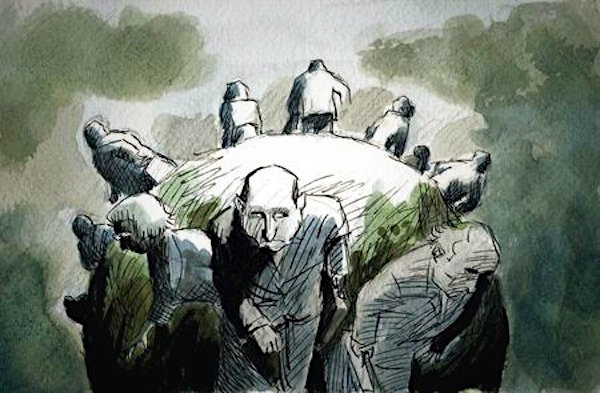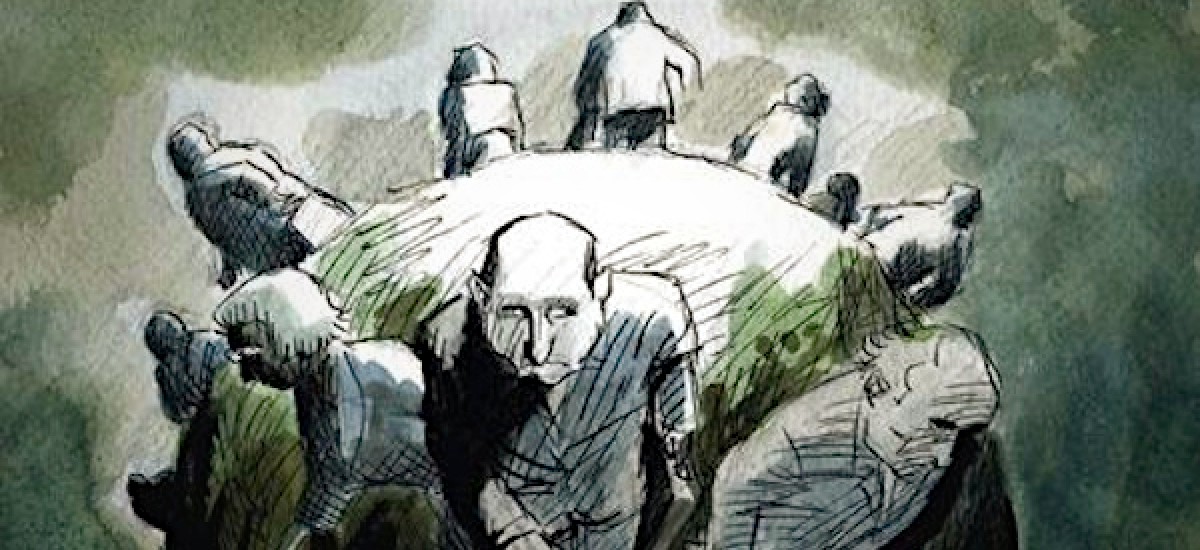
Illustration by Claudio Munoz, courtesy the Economist
“Do not look a gifted horse in the mouth” – So goes an old adage. The import of this statement would seem to be: except a gift with gratitude and do not question its value for after all, it is a gift. It would seem that we have as a nation accepted many gifts in this spirit. A fleet of tractors or a thousand tonnes of pesticide does indeed seem to be a generous expression of friendship. These offers are made by the donors in a genuine effort to help the least privileged nations and our accepted in gratitude with the hope that these gifts will help lighten our national load. But, it may be time for us to question such gifts however well intended they may be.
A case in point is the “miracle rice” that gives an immediate manifold increase in crop over traditional varieties. This would seem indeed a welcomed gift, if not a virtual godsend in troubled, food scares times like this. The reckoning is simple, if we have an acre of paddy with a yield of 30 bushels, then all we need to do is transform to the new intensive varieties that give twice the original yield and we have 60 bushels with the same acreage. Presto! The problem is solved. Not quite: there is an important feature called energy that we often fail to take into our accounting.
Energy is one of the most important features of an ecosystem. At the human level, the food we eat represents the source from which we derive energy for all our functions. This food too, whether animal or vegetable in origin, requires energy for its organization. Animals like us, derive their energy from plants and other animal (heterotophs) and most plants derive their energy form the sun (autotrophs). Therefore, as we are so dependent on energy, it would bode well for us to examine the sources and cost of the energy available to us.
One of our primary sources of food is rice. The agricultural system that yields this grain requires some extra input of energy in addition to the sun to make it yield utilizable crops.
The traditional varieties of rice used with traditional agricultural methods, utilize composted fertilizer and animal power as the source of extra energy for production. This type of system use 0.062 to 0.15 calories of energy subsidy for one calorie of food output. As this energy input is basically biological i.e. man and animal power, it does not represent an economic loss to the nation. On the other hand the use of “miracle rice” intensive agricultural systems which often uses around 0.6 to 0.8 calories of energy input for 1 calorie of food output entail heavy doses of fertilizers and agrochemicals do represent tangible financial or economic pressures on the nation.
It can be argued that, though such a system may entail finance cost to the country the increase of crop by the application of these techniques would justify such an expense, specially as in the present situation we are still not self sufficient in our rice production. This argument is a valid one, if we are concerned only with a short-term result. Unfortunately, on the long term it would seem that we stand to lose tremendously in adopting such strategy.
The new breeds “miracle rice” are merely genetically selected dwarf plants with small roots systems and the minimum amount of leaves needed to capture a maximum of usable solar radiation. Such a plant has not potential for protection and maintenance, these functions being take n over by men, fuels and chemicals. It is selected to produce edible grain at the expense of non-edible tissue and responds excellently to high inputs of fertilizers. Such plants coupled with the use of tractors, pesticides, weedicides, etc. would and do produce seemingly wondrous crops.
All the components that go to form this high yield agriculture are also dependent on energy for their organization. In this case the source of energy is from fossil fuels i.e. oil and coal. We in this country having no fossil fuels would then become increasingly dependent on imported energy, if such methods of agriculture were to be actively utilized. Achieving a high agricultural productivity at the expense of being enslaved by the price of fossil fuel would seem a hollow victory.
It would be illuminating to ask the question why could we not use these methods as long as it was economically profitable and then revert back to the traditional systems? The answer is already obvious to the farmers who use high-energy agrochemicals. They observe that their field “gets burned” with the use of fertilizer and agrochemical. The meaning of this simple but very important observation is that the soil organisms that make up the micro fauna and flora are disrupted and the natural fertility of the field falls. The build up of the soil organisms to the pre agrochemical complexity could take from one to four years. So, once we depend on the high-energy dependent rice agricultural system it is very much a case of taking hold of the proverbial tigers tail, there is not letting go.
Do we really need these high fossil energy systems? It may be we do, but the dangers to the country should be carefully evaluated. It may be wise to examine gift horses”
The words above were published in 1977, when the country stood poised to leap into the ‘Green Revolution” . It is 2011, today 34 years from then, we can gauge the affectivity of agricultural pundits of that day when they chose to push us into the ‘Green Revolution” and “Globalization” processes and proceeded to burden the nation with a crippling debt and proceeded to turn the farmer into a statistic. The first has us enmeshed in the need to provide an annual subsidy of Rupees 50 billion for high fossil energy fertilizers; the other has reduced the farmer to the simplest social profile where, his poverty facilitates the loans that will propel us on the road to ‘Development and Progress’
Development and progress, are words that we are very familiar with, and rightly so. As a nation all our hopes and aspirations are centre around the promises attendant on this processes. However, recently there have been some questions on the values of “development” and as in every controversial issue the battle lines have been drawn. The combatants are, as is usual in these affairs, mostly from developed countries and the people of developing countries more often than not, are mere witnesses to these esoteric exchanges. I do not intent to imply that these arguments are not valid; rather I would like to draw attention to the fact that often both points of view have their references deeply rooted in ‘developed’ or western technological thought., which in the end, merely means an increase in industry and consumerism. It most certainly could not refer to a cultural or a philosophical development. If that were so, a country in which a major part comprehends philosophical concepts that are addressable only by a minority of scholars in the West, must certainly, in comparative terms, be more developed.
In the modern world active research in under way for such fossil fuel unsubsidized systems. We had it, and disrupted it in favour of energy intensive agricultural practices. Propelling us into the repercussions of increased energy dependence. Through the current frenzy of energy production using of fossil energy accompanies other important goals of Globalization, such as:
- Discounting of production for the domestic market in favour of production for export markets
- Discounting of production for the domestic market in favour of production for export market.
- Subsidizing movement of goods by encouraging production at centralized remote locations
- Creation of systems of trade that circumvents traditional national barriers
- Facilitation of subsidies that encourage fossil energy consumption
- Emphasis on material growth.
The current global crisis demonstrates that another way has to be found. The discourse has begun. The term “Deglobalisation,” coined by Walden Bello proposes a different paradigm to that of Globalisation. He suggests that there are 11 key prongs of the “Deglobalisation” paradigm:
- Production for the domestic market must again become the center of gravity of the economy rather than production for export markets.
- The principle of subsidiarity should be enshrined in economic life by encouraging production of goods at the level of the community and at the national level if this can be done at reasonable cost in order to preserve community.
- Trade policy – that is, quotas and tariffs – should be used to protect the local economy from destruction by corporate-subsidized commodities with artificially low prices.
- Industrial policy – including subsidies, tariffs, and trade – should be used to revitalize and strengthen the manufacturing sector.
- Long-postponed measures of equitable income redistribution and land redistribution (including urban land reform) can create a vibrant internal market that would serve as the anchor of the economy and produce local financial resources for investment.
- De-emphasizing economic growth, emphasizing upgrading the quality of life, and maximizing equity will reduce environmental disequilibrium.
- The development and diffusion of environmentally congenial technology in both agriculture and industry should be encouraged.
- Strategic economic decisions cannot be left to the market or to technocrats. Instead, the scope of democratic decision-making in the economy should be expanded so that all vital questions – such as which industries to develop or phase out, what proportion of the government budget to devote to agriculture, etc. – become subject to democratic discussion and choice.
- Civil society must constantly monitor and supervise the private sector and the state, a process that should be institutionalised.
- The property complex should be transformed into a “mixed economy” that includes community cooperatives, private enterprises, and state enterprises, and excludes transnational corporations.
- Centralised global institutions like the IMF and the World Bank should be replaced with regional institutions built not on free trade and capital mobility but on principles of cooperation
Such a process could help us out of the morass of debt, that we find ourselves sinking in. It will help control the rabid rush to profit from the commissions attached to project loans, pushing us ever deeper into debt. But entering such a process requires great courage and commitment at a national level; do we have it?

